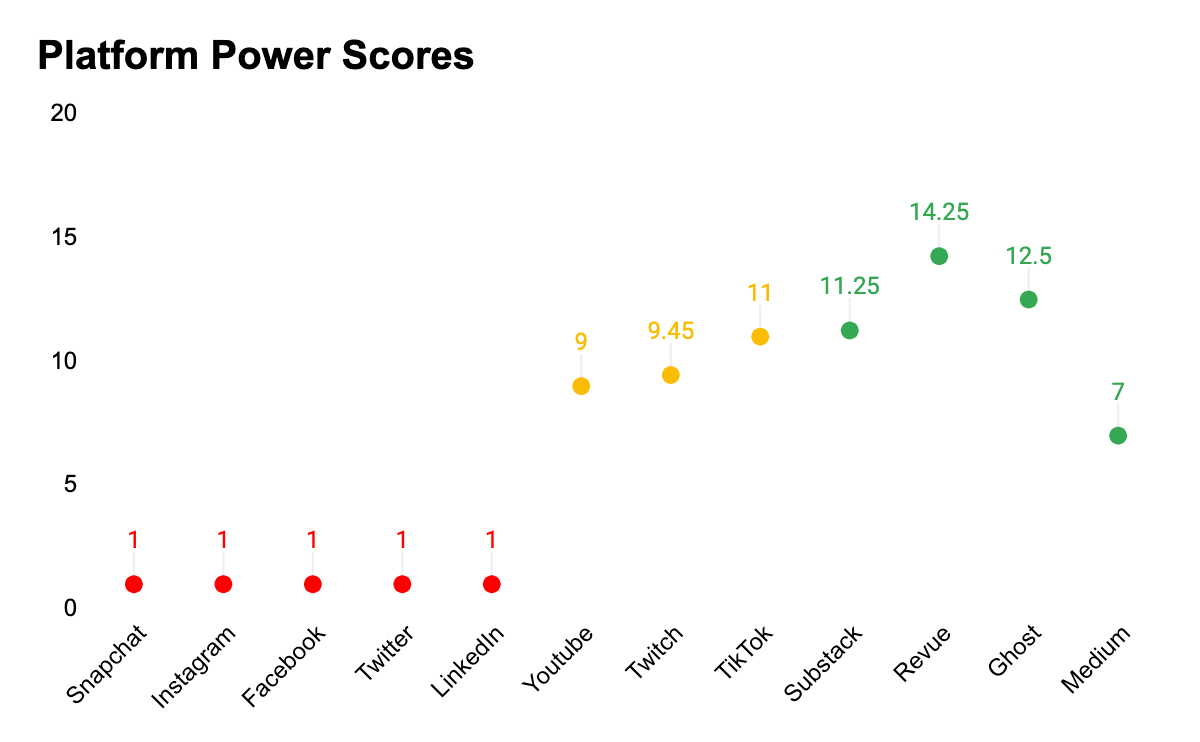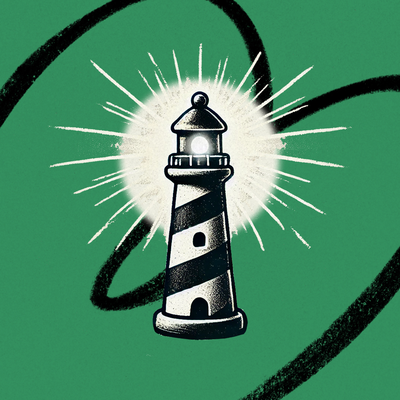
Quick note - thank you for being patient with me as I have been relatively sparse with my publishing over the last few weeks. I got married and it turns out the whole wedding thing tends to be a large consumer of time (and dollars). Rest assured, I am back and am here to publish some bangers over the upcoming months.
Accordingly, with my newly obtained status, I need your help.
What marriage advice would you offer me, a newlywed?
Just respond to this email with what you wish you had known when you first got married and I’ll respond. If we get enough interest, I’ll post some of the best responses next week.
Thank you for the help (and saving me from doing something stupid a new husband typically does lol).
Is there any place on the internet that isn’t a ripoff? More specifically, is there a website where a creator can go and receive a fair amount of money for the stuff they are making?
Two weeks ago, to help answer this question, I published my newest theory - the Creator Power Scale. The goal was to give the people a slightly more quantitative way to evaluate creator platforms. I ran the formula on Twitch as an example and discussed the implications. Reader response was really strong with lots of discussions in my Twitter DMs and Discord servers.
The natural question most people wanted to know is: how do the platforms stack up against each other? While comparing individual providers is much more of a feature comparison exercise, comparing competing mediums/monetization models gives unique insights into the power structure of the market.
The Formula and the Math
As a reminder, the formula was,
(Platform Attributable, Unique Eyeballs
+
Content Creation Barriers to Entry
+
Average Revenue Generated Per User
+
Audience Portability)
X
Percent Creators Get to Keep
= Creator Power Scale Score
Each Variable is scored from 1-5—the higher the better. So I did a bunch of research and did my best to come up with an objective ranking of how the major creator platforms fared against each other. You can see individual scores here, but first let me walk you through the overall conclusions.
When you run all the major platforms through the formula there are clear clusters of scoring.
There are essentially 3 clusters.
At the bottom are the social media platforms. This was actually a really tough call! All of these offer such superior demand aggregation to any other offering that they should win on default. However, they barely share revenue with creators at all. When they do, it comes in the form of opaque “Creator Funds,” which are unreliable and not a way for a creator to build a real business. This swayed me into the “social media takes 100% of value” camp. If you were to argue instead that they actually allow creators to retain all of their revenue (creators can do sponsored content deals and the platform doesn’t take a cut) the average score would be 9.
The middle sector is the video platforms: Youtube, Twitch, and TikTok. These sites have the most developed creator ecosystems. They can funnel millions of viewers your way (if you can somehow penetrate their inscrutable algorithm) and offer a variety of monetization tools. Note: TikTok only has a creator fund but their Chinese sister product has multiple revenue streams for creators. My discussions with sources at the company indicate similar efforts are underway. However, they generally suffer from a lack of audience portability.
Finally, we have the new hotness—newsletter platforms. Here we have the current all-in-one leader of creator platforms, Revue. Their unique ability to aggregate demand via Twitter’s users, coupled with one-click subscribe buttons on your Twitter profile, plus a lower take rate than places like Substack makes their offering a compelling one. (Disclosure, I worked at Substack for a hot minute before the pandemic.) Regardless, all the newsletter platforms offer an extreme amount of audience portability coupled with a minimum $60 annual revenue per user, making these the best-performing creator platforms.
Note: There is also the weirdness that is Medium which has gone through so many pivots that I don’t even know what to classify it as anymore. The right answer is probably a ripoff lol.
However, my formula doesn’t capture all the nuance (nor was it meant to!). Here are some additional layers of insight that this graph hints at.
It Ain’t Great Chief
You’ll notice that all of these are less than 15 of the 20 points. As much as my GPA may wish it, 75% isn’t exactly a stellar score. This reflects the reality of being a creator—it is hard. You are at the whim of the big platforms. They host the entire audience that you are so desperately trying to contact. You are competing against other media companies that have sophisticated technology stacks and hordes of growth marketers devoted to the same platform you are on. There are millions of people who would take your job. The platforms that score highest (newsletters) partially do so because they are competing on an open protocol. Email is available for everyone and the pricing power just isn’t as strong there.
Eyeballs Rule the Battle
The platforms that score the worst (e.g. Instagram and Facebook) are still the most popular among creators. By virtue of simultaneously being the largest network and having the most sophisticated ad targeting tools, they will be where all creators have a presence. The audience is so valuable that creators are willing to go through the pain of finding their own sponsors or doing anything else that they can to get revenue.
Multi-Platform, Multimodal
Perhaps the ultimate weakness of this formula is that it views each of these platforms in isolation. Competition is the best driver of efficiency, so by playing each platform off of each other creators are able to be successful. The canonical example is the Twitter to Substack pipeline. Many (if not most) successful Substacks are built on the back of pithy tweets. Substack offers minimal to no demand aggregation so creators with large Twitter followings funnel their followers to their email newsletter. Similarly, TikTok stars also point their viewers to their Youtube page because Youtube offers more robust monetization options.
To further weaken this formula’s justification to exist, the revenue streams are multi-modal too. There are an increasing number of technology startups that make it easier for creators to generate new revenue streams off their existing audiences. For B2B content like mine, job boards are popular. More consumer entertainment creators can use services to sell jewelry, skincare products, or anything else.
So you put that all together, where does it leave us?
Power and Crypto
Feeling pithy a few nights ago, I tweeted,
I awoke to my editor Nathan disagreeing with me via Discord DM (we disagree a lot, you would be surprised how many of our respective essays come from us arguing ha). His argument was that while yes Web3 doesn’t fix attention power laws, it does a lot of other useful and new things. Community building, monetization methods, all of it looks different with Web3.
(Note: I have been studying Crypto for some time now and I think it is time for me to start publishing some analysis on it. Unlike most of my fellow Every writers, I remain firmly in the skeptic camp. However, cryptocurrencies' combined value sits in the trillions. Lots of smart people are jumping on board. I would be a poor analyst if I didn’t cover it in some way. Rest assured it will be done accessibly and simply. If there is anything you want to see me write about, let me know.)
I am of the opinion—informed by my personal experience as a creator, my experience doing consulting work for creator economy startups, and my relationships with other creators—that the thorniest problem for creators is attention. It is near impossible to get and even more impossible to keep. While there is an argument to be made that if a creator has a tokenized community their financial incentive to spread the good news of content helps attention generation, Web3/Crypto does not truly solve for attention power laws.
The reason Revue scores so well is because it is the only one that combines the demand aggregation capabilities of a social network and the monetization strength of newsletters. Until a platform comes along that can do that, everything else is just a fun little bonus.
Find Out What
Comes Next in Tech.
Start your free trial.
New ideas to help you build the future—in your inbox, every day. Trusted by over 75,000 readers.
SubscribeAlready have an account? Sign in
What's included?
-
Unlimited access to our daily essays by Dan Shipper, Evan Armstrong, and a roster of the best tech writers on the internet
-
Full access to an archive of hundreds of in-depth articles
-
-
Priority access and subscriber-only discounts to courses, events, and more
-
Ad-free experience
-
Access to our Discord community






Comments
Don't have an account? Sign up!
Advice to a newlywed: "love" is an almost meaningless word. Try caring for your partner, instead.